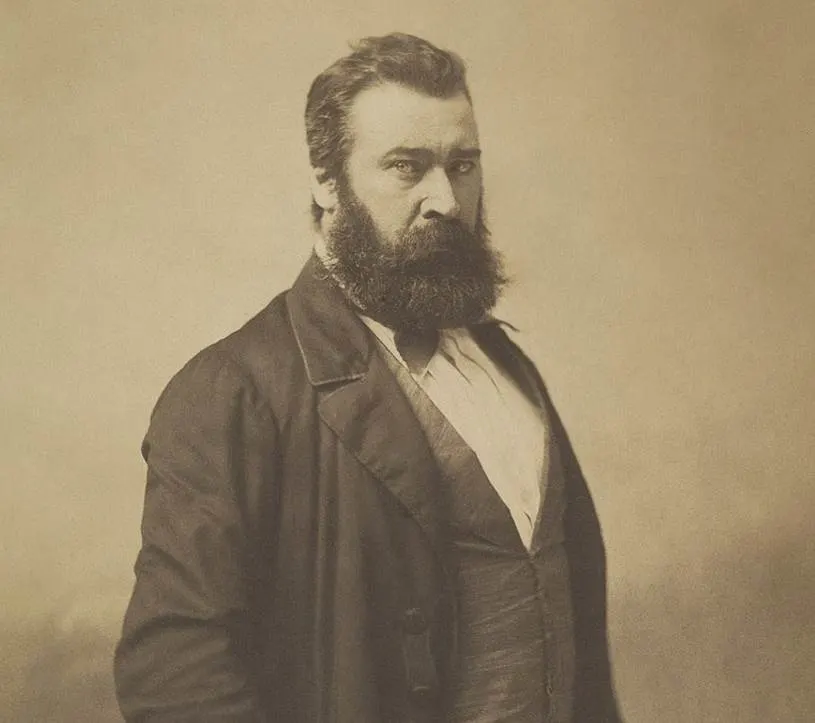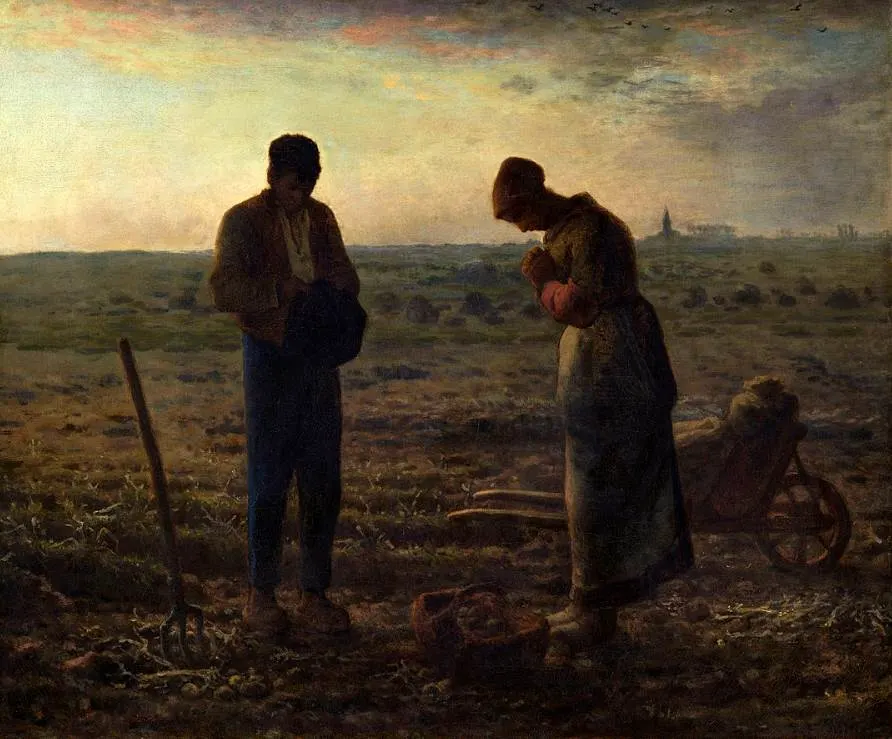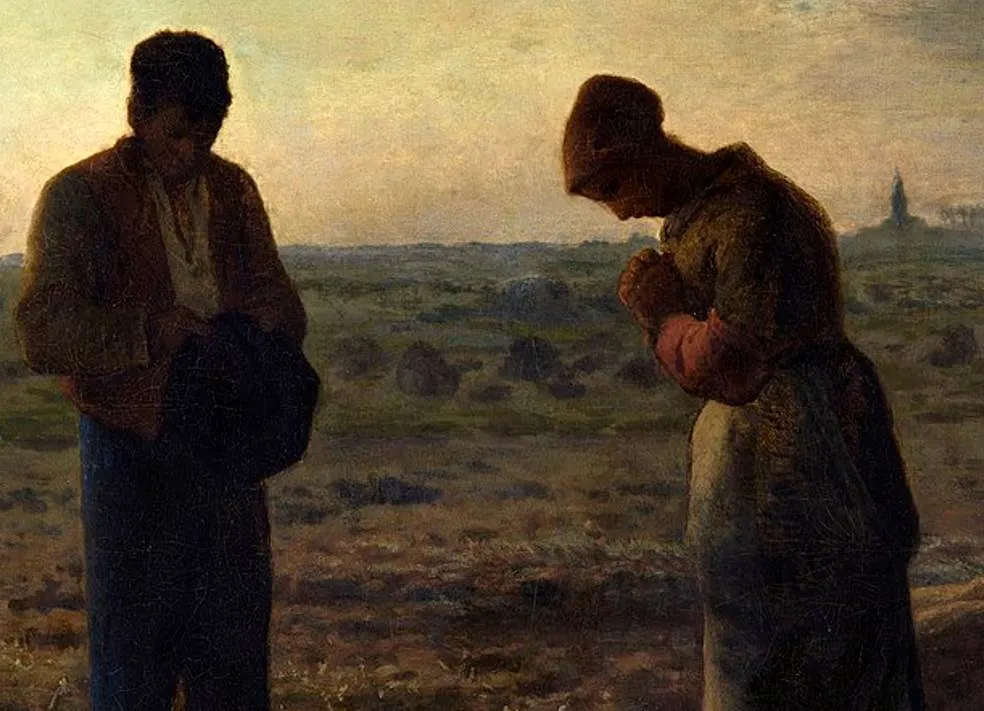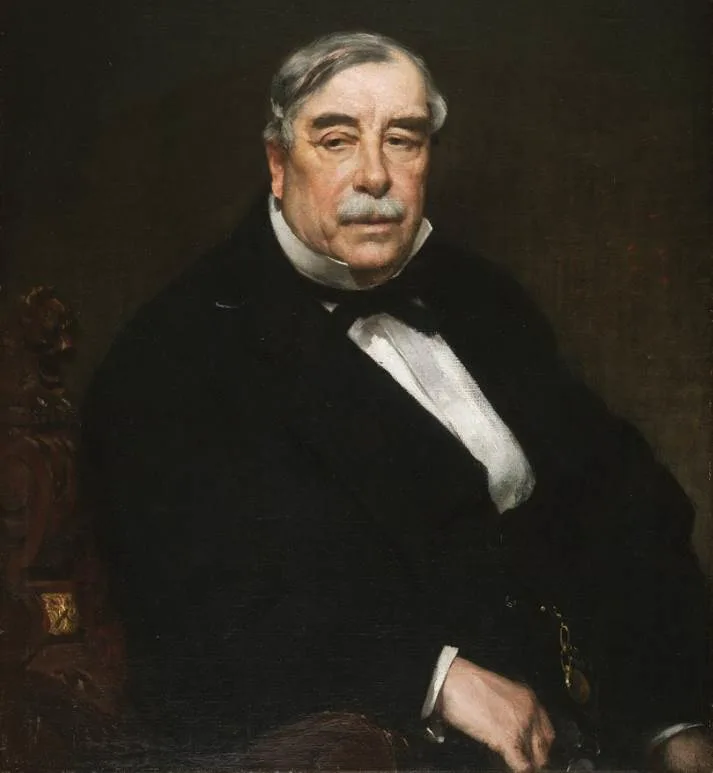When this French artist moved from Paris to the countryside just south of Paris, he became the founding father of a group of artists now known as the Barbizon School.
Jean-François Millet (1814-1875) produced some of the most iconic Realism paintings during the 1850s, mainly focusing on peasants and their hard life in the field.
In this article, we’ll take a closer look at some of the most interesting facts about The Angelus by Millet, an important painting by the artist for multiple reasons.
1. It was completed shortly after Millet finished his best-recognized work
The Angelus is a famous painting by French Realism artist Jean-François Millet. He was the founding father of the Barbizon School of painting after he moved there in 1849.
He grew up in the Normandy Region of France and was accustomed to hard labor in the field. He never lost touch with his roots so to speak, even though he lived in Paris for extended periods.
Struggling to find his true identity as an artist and after a failed attempt to get his work exhibited at the Paris Salon, he decided to start drawing inspiration from real life.
Peasants in the area of Barbizon became his main source of inspiration during the 1850s, culminating in his most important work titled “The Gleaners” (1857).
He completed this painting between 1857 and 1859, and shortly after he managed to sell his epic work for a handsome amount at the Paris Salon of 1857.

2. It depicts two peasants conducting the Angelus in a field near Barbizon
The Angelus is a type of prayer in which Catholics commemorate the Incarnation of Christ. The painting depicts two peasants on a field who are saying this prayer.

The prayer’s name is derived from the first few words of it in Latin “Angelus Domini nuntiavit Mariæ.” This means “The Angel of the Lord declared unto Mary.”
Millet said that he was inspired by his grandmother saying this prayer while the church bells rang while she was working in the field.
The church in the background is a reference to this. This is the church tower of Chailly-en-Bière, a small rural town just north of Barbizon
This is situated in the Seine-et-Marne department just south of Paris at the western edge of the huge Forêt de Fontainebleau.

3. The true relationship between the two figures remains a mystery
The evening appears to be approaching which means that it’s likely that the two peasants are saying their prayer at the end of the day’s work.
We can see a pitchfork, a basket of potatoes, and a cart. We don’t know who these peasants are and various suggestions about their relationship have been made.
Some of these suggestions are:
- Colleagues at work.
- A married couple.
- A farmer and his maidservant (the common interpretation in the 19th century).

4. Salvador Dalí identified the painting as a funeral scene
The Spanish artist Salvador Dalí (1904-1989) once saw a replica of the painting in his school as a child and was freaked out.
He didn’t interpret the wok as merely two peasants saying a prayer to honor the people who had passed but saw the scene as a burial.
Never shy to speak his mind, the Surrealist artist even took it a step further and concluded that it was a married couple who was mourning their dead infant child.
Although nobody took Dalí’s interpretation seriously, an x-ray conducted at the Louvre Museum confirmed that Millet overpainted a shape that resembled a coffin.
The conclusion was that Millet most probably started this work as a burial similar to Gustave Courbet’s painting titled “A Burial at Ornans” (1850) but changed his mind later on.

5. It was commissioned by an American who never collected it
what’s remarkable about this painting is that it was commissioned by an American artist and art collector from Boston named Thomas Gold Appleton (1812-1884).
Although Appleton never really managed to carve out a career as an artist himself, he was the son of a rich merchant which allowed him to become a patron of the arts.
The original title of the work was “Prayer for the Potato Crop” but when Appleton failed to collect his commissioned work, Millet changed the title to “The Angelus.”
This also means that he only added the church in the distance at a later time to complement the new title.

6. It became one of the most reproduced religious paintings of the 19th century
Equally fascinating is that the painting was initially considered to be a work that featured a political statement.
Just like Courbet, Millet was classified as a socialist by the establishment in France and was a little too sympathetic to the working class.
It was only after this initial storm of criticism settled that Millet’s masterpiece was considered to be an expression of religious devotion.
It eventually became one of the most reproduced works of art of the 19th century and prints could be found in countless households in France.

7. How big is The Angelus by Jean-François Millet?
This painting is a relatively small work of art as it’s only just over half the size of Millet’s famous The Gleaners. This was also why he only managed to sell it for 1,000 francs.
The Angelus by Jean-François Millet is an oil on canvas painting that has dimensions of 55.5 × 66 centimeters (21.9 x 26 inches).

8. Where is the painting located today?
The painting switched hands multiple times after it was initially sold for 1,000 francs in 1860 to a Belgian artist named Victor de Papeleu.
The first time that the painting was exhibited was in Brussels in the year 1874. This increased its value tremendously as it was sold for 168,000 francs in 1881 to a French copper industrialist.
The Louvre tried to buy it in 1889 but was outbid by the American Art Association which paid 553,000 francs for the work.
A good investment because just a year later, they sold it to the French art collector Hippolyte François Alfred Chauchard (1821–1909) for 750,000 francs.
It was eventually bequeathed to the French state and after being on display at the Louvre between 1910 and 1986, it was transferred to the Musée d’Orsay in Paris in 1986.

